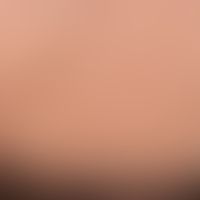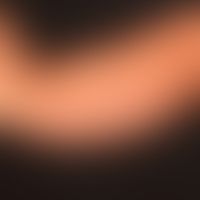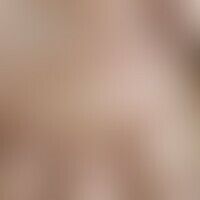Image diagnoses for "skin-colored"
275 results with 593 images
Results forskin-colored

Swelling of the eyelids
Swelling of the eyelid: Recurrent, painless swelling of the left upper lid (always) in Melkersson's disease - Rosenthal's syndrome

Alopecia areata (overview) L63.8
Alopecia areata: Still relapsing-active alopecia areata: Marginal area, cadaverized hair and exclamation mark-like hair, as a sign of the still existing progression of the process.

Angioedema (overview) T78.3
angioedema. acute, transient occurrence of diffuse, pale, slightly itchy, doughy, edematous swellings of the skin. the joint contours appear to have elapsed. in the case shown, the face and mucous membranes were also affected. there was also laryngeal edema.

Dermatofibrosarcoma protuberans (overview) C44.-
5 cm large papular infiltrate on the shoulder of a 31 year old female patient. 4 years of multiple steroid infiltrations as an acne node.

Nail hematoma T14.05
hematoma, nail hematoma. blue-blackish, sharply defined pigmentation (here of the big toe nail) due to a previous traumatic event. no distal stripy nail discoloration. the absence of distal stripy nail changes excludes the important differential diagnoses "subungual malignant melanoma" and "subungual melanocytic nevus".

Cheilitis actinica chronica; chronische aktinische Cheilitis; L57.8
Cheilitis actinica chronica: extensive veil-like leukoplakia of the red of the lips with increased radial furrowing.

Heberden's knot M15.1

Aplasia cutis congenita (overview) Q84.81
Aplasia cutis conenita: Cheek on the right. Symptomless, sunken, scarred lesion.

Vascular malformations Q28.88
Malformation, vascular: mixedvenous/arterial malformation with discrete capillary involvement.

Pachydermoperiosteosis, primary M89.4
pachydermoperiostosis, primary: A 32-year-old man of Han Chinese origin presented with a 15-year history of a peculiar facial appearance (Panel A). after puberty, he had noticed a progressive enlargement of his hands and feet as well as facial furrowing. the patient reported that the progression of disease had stabilized by the time he was 27 years of age. on examination, he had excessive sebaceous secretions and thick, furrowed, and redundant skin on his forehead, cheeks, and chinese. soft-tissue hypertrophy reduced the motion of his hands and feet, with terminal broadening of the fingers (Panel B) and toes and cylindrical enlargement of the limbs. the patient received a clinical diagnosis of pachydermoperiostosis, a rare genetic disease characterized by pachyderma, digital clubbing, and periostosis. his parents and son did not have similar symptoms; no genetic testing was performed. the therapy was performed in two stages. in the first stage, we implanted an expander under the patient's forehead skin to enlarg

Neurofibromatosis peripheral Q85.0
Neurofibromatosis peripheral: circumscribed dewlap-like overlapping, soft new formation.

Striae cutis distensae L90.6

Bubble
Bubbles: areal blistering in Cheiropompholyx. 32-year-old female patient complaining of recurrent blistering on the lateral edges of the fingers. In a very warm outside temperature massive, at first itchy, later painful blistering occurred. Smaller blisters appearing only in the area of the palms (groin skin) (left margin of the picture), which first form flat blister aggregates and then merge into large, blurred blisters (middle of the picture).

Arsenic keratoses L85.8

Nevus melanocytic (overview) D22.-
Usual melanocytic nevus. type Lentigo solaris. Chronic stationary, no longer increasing, sharply limited, symptomless, axisymmetric, 1.0 x 0.6 cm large, brown spot on the auricle of a 36-year-old woman.









